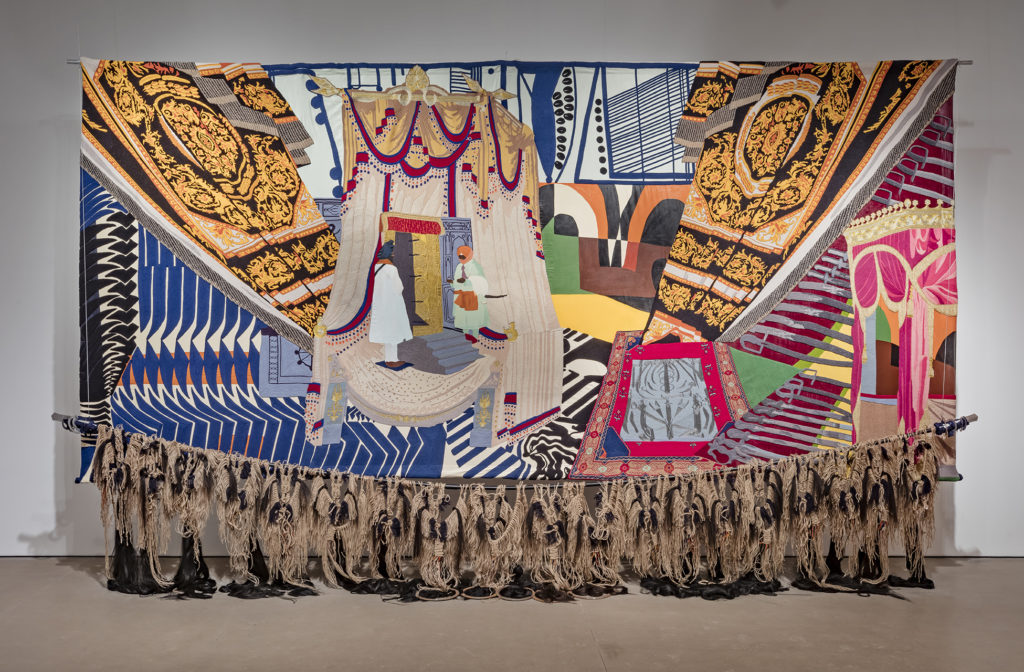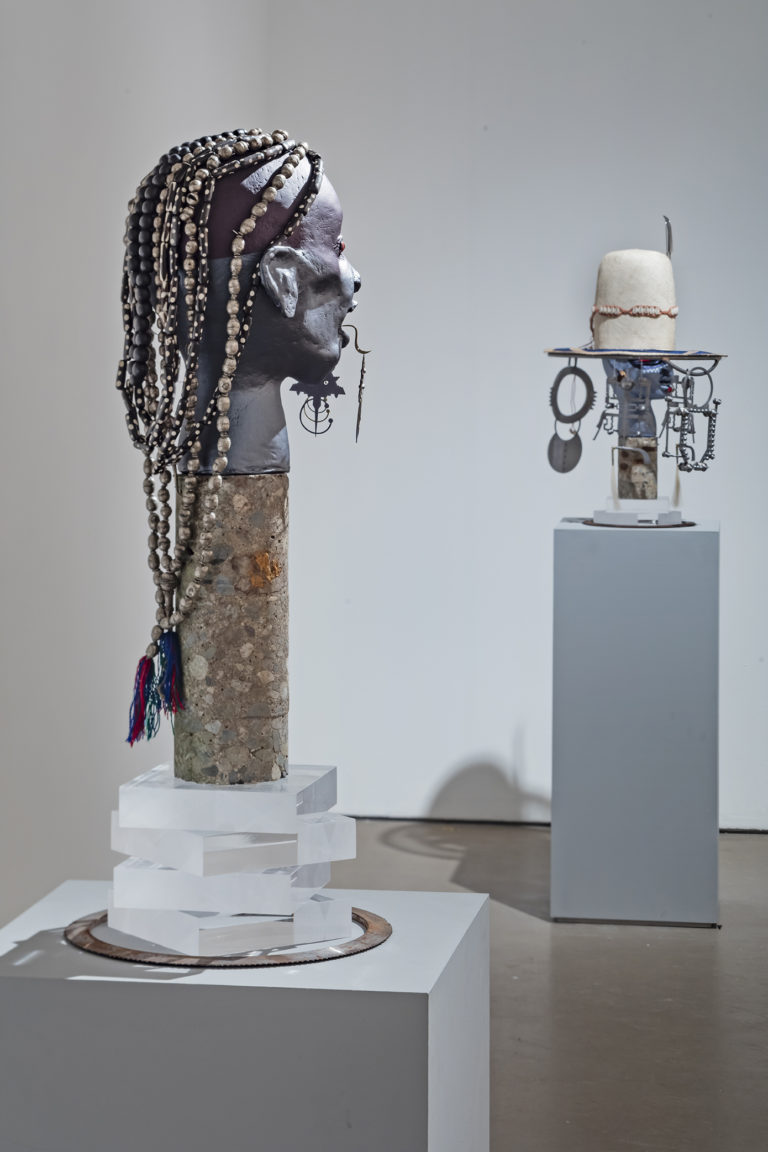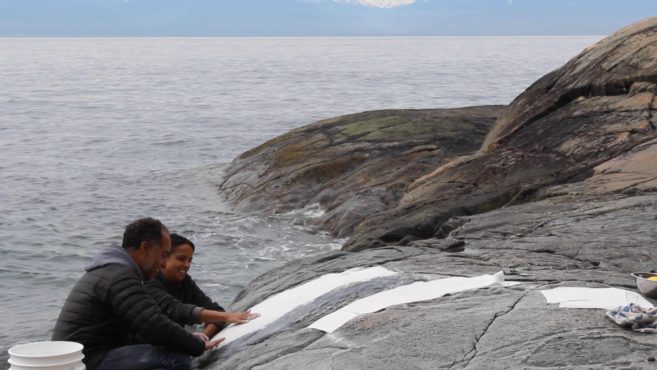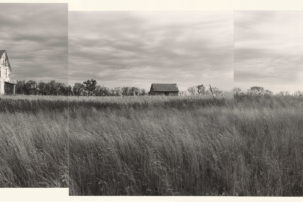Nep Sidhu’s remarkable exhibition Medicine for a Nightmare (they called, we responded) opened in February at Mercer Union in Toronto. On his Instagram feed the artist highlights his endeavours, here and in India, to build up Sikh community and teachings. For this exhibition, Sidhu set out to make art about recalling and healing from Operation Blue Star, a violent attack on Sikhs by the Indian military in the Punjab region of India in 1984. This moment is a part of a long and tangled history, one which arguably goes back to Sikhism’s beginnings 500 years ago, and which persists today between Sikh communities and the Indian government.
I spent an afternoon alone with the works and left the gallery feeling like a weight had been lifted. What I saw was a narrative long kept silent, here depicted in bright colours, metallic sculpture and concrete. Several large tapestries with guns and swords woven amongst symbolic abstractions hung near a series of busts. In a smaller back room was a large photograph of kitchen steelware and a concrete sculpture with more direct representational reference to the Golden Temple’s form and the Sikh practice of seva (service). I was very moved by this body of work, which seeks to document an event never spoken about in my Sikh family. I only learned of Operation Blue Star and its context as an adult, after watching the 2005 movie Amu and then doing my own research.
In June 1984 then prime minister of India Indira Gandhi planned Operation Blue Star and ordered the Indian army onto the grounds of the Golden temple to remove militant religious leader Jarnail Singh Bhindranwale, who was championing the creation of a separate, theocratic state for Sikhs. For several years, Bhindranwale, who died during Operation Blue Star, had used the temple as a base to incite violence, which had in turn led to hundreds of deaths and many more injuries. Soon after Operation Blue Star, Indira Gandhi was assassinated by her two Sikh bodyguards and riots erupted in Delhi. Enclaves of Sikhs were set on fire, women were raped and children were taken. An aunt of mine fled the country for two months, to wait for tensions to calm down. The following year, Air India flight 182, leaving Toronto for India, exploded as it neared the coast of Ireland, and caused the death of all 329 passengers and crew members. Twenty years later, the Babbar Khalsa, a BC–based Khalistani Sikh militant organization, was found guilty of orchestrating this terrorist attack as a response to the 1984 assaults on Sikhs in Punjab. Tension between the Sikh community and ruling Indian governments can be traced throughout the religion’s history, but the events of 1984 were a pinnacle.
This exhibition is problematic because Sidhu’s works speak specifically to one event and portray only one side of the story, without context. A few days after seeing the exhibition, I attended a community meeting where fellow queer South Asians from the art community expressed disappointment at the works, at Sidhu, at the curatorial decisions and at the curator’s essay. Many felt like the show invoked the violent, separatist Khalistani movement. For those affected, moving on from Operation Blue Star meant forgetting, but for me and the generation to which Sidhu and I both belong, healing is about remembering.
RRK: Your work has evolved and transformed in many ways over the past decade. What influences the subjects you make art about, the materials you work with and the medium or form works take?
NS: It’s tended to be what’s been around me, how I grew up and the attitudes of the elders in my house and in my community. I grew up in a home with 18 people. It’s tough to tell when a Punjabi is coming, going, or is going to stay a while. I think the codes of such a household are what have driven my work, and the type of engagement that draws me.
There were no practicing artists in my family but there were examples of being a certain way, and of carrying oneself in one’s community, that have stayed with me. For example, my grandfather had a strong military background and quite an intense and large presence wherever he roamed. When there was a wedding ceremony at the gurdwara, relatives and strangers alike would often ask him to say some words as a blessing. With the audience expecting a sweet tale of harmony for a new couple, he would instead take the opportunity to speak about dowries in the community, denouncing them and publicly shaming anyone that took part in them, from the obvious gift exchange (which would have taken place minutes before he took the cordless mic) to the domestic mindset of a lifelong burden. These are the types of ideas and examples that find form in my work.
In terms of material, fibre attracts me for its capacity to “carry within.” In being able to receive and then share its stored record/memory/knowledge, it acts as a custodian, and this particular conduit-like function has been instrumental for me. The works are charged in terms of sharing experience and providing confirmations in an embroidered grammar of the divine. The production of textiles is rarely a solitary affair, and there’s a certain workshop-like activity in building large-scale. I’m thankful to produce such works with the assistance of both Olivia Dar and Rashmi Varma, who shared their studios in India, and with whom I have developed specific techniques and sequences of approach alongside various karigar teams.
 Nep Sidhu, Medicine for a Nightmare (from the series When My Drums Come Knocking, They Watch), 2019. Cotton, wool, jute, zari, hair, steel, 559 x 274 cm. Commissioned by
Mercer Union. Photo: Toni Hafkenscheid. Courtesy the artist.
Nep Sidhu, Medicine for a Nightmare (from the series When My Drums Come Knocking, They Watch), 2019. Cotton, wool, jute, zari, hair, steel, 559 x 274 cm. Commissioned by
Mercer Union. Photo: Toni Hafkenscheid. Courtesy the artist.
RRK: Do you feel responsibility for the ways you present Punjabi and Sikh identity?
NS: I do. I feel it would be naive to put this work out into the world and not feel I should be held responsible. At the same time, in the landscape of the contemporary art world, such work can be held up unfairly as a monolith in terms of its representation, simply because there isn’t enough of it. That’s why it was important to me to ensure that dialogue between the programming, the publication and the show’s works engage a sustainable conversation with the healing of trauma, while at the same time pointing to modern-day participation of people in the community working with the intention of the works in various fields. Shows will come up and down, but I wanted to help that example and conversation to begin to be more sustainable.
RRK: What are your thoughts on the community responses, and to curator cheyanne turions’s rewriting of the essay and inclusion of an annotated bibliography?
NS: The community response at large has been overwhelming. It’s been a full range—from elders who feel safe sharing their experiences of the intensity and despair around the anti-Sikh pogroms of Delhi to women having to cope with and move on from the experience of widow colonies and leading a life of isolation. Being able to speak to young Sikhs about being connective and expressive were some of the brightest moments [for me].
“It was always clear to me…that the show would require a lot of discussion for those willing to openly engage.”
As for [rewriting the] essay, it was always clear to me and cheyanne that the show would require a lot of discussion for those willing to openly engage. That was part of the work. The show at Mercer Union was only the beginning. Although there is multiplicity in the works in the space, there are also many conversations and interviews, and a collection of released and unreleased data I was hoping to present in an adjoining publication for the show, about experiences that act as lenses on our uninterrupted practices—practices that connect to the traditions referenced in the show. So along with the essay and programming, we called on the voices of others, in hopes that the show would contribute to a space where we could continue to expand and share our experiences and practices.
RRK: In the show, there are three busts of Black people, with bases that reference Indigenous iconography. This feels like appropriation, like you’re making a connection to Sikh history that does not parallel the histories of Black liberation or Indigenous sovereignty. How do you respond to this critique?
NS: Liberation from colonialism and sovereignty are not monolithic in any of the cases referenced, so commonalities run from many places in parallel and practice here. I think that the critique comes from of a certain type of human assembly that has been “learned” and trained, in this case, to look at the Black experience as standing only for liberation at all times in some kind of rebellious product-placement way, when actually Black experience is about being connected, shared and learned from the whole. What’s also telling in the critics you speak of is their conditioning to think that when they say Indigenous, they mean “non-Black.” In this work, when we say Indigenous, we are speaking to several incarnations of the “Black body” that, as history and geography tell us, can be found the world over. I think this critique serves a purpose—it’s more telling of its author than it is of what they are actually looking (or not looking) at, especially when they end up embarrassing themselves by saying things like “There was a lack of female forms in this show.” Those critics trip over their own manicured punchline, which ends up being its own sort of performative satire. The bodies [in my work] are all based in physiognomies that reference our mothers and sisters in a universal sense. Where those critics try to inject appropriation, we see advancement.
 Nep Sidhu in collaboration with Maikoiyo Alley-Barnes, The Books and the Scripts Were Stolen, Our Steel Is Forever, Mool Mantar Medicine Hat 7a, 2019. Stainless steel, beaver, felt, 38 x 81 x 38 cm. Photo: Toni Hafkenscheid. Courtesy the artist.
Nep Sidhu in collaboration with Maikoiyo Alley-Barnes, The Books and the Scripts Were Stolen, Our Steel Is Forever, Mool Mantar Medicine Hat 7a, 2019. Stainless steel, beaver, felt, 38 x 81 x 38 cm. Photo: Toni Hafkenscheid. Courtesy the artist.
 Installation view of “Nep Sidhu: Medicine for a Nightmare (they called, we responded),” Mercer Union, 2019. Photo: Toni Hafkenscheid. Courtesy the artist.
Installation view of “Nep Sidhu: Medicine for a Nightmare (they called, we responded),” Mercer Union, 2019. Photo: Toni Hafkenscheid. Courtesy the artist.
RRK: I was four in 1984, and so wasn’t aware of the extent of events around Operation Blue Star. Much like partition, my family didn’t talk about it. It wasn’t until I reached my twenties and had moved to Canada that I saw the movie Amu, where learned about the 1985 Air India bombing and began reading about the atrocities. Can you tell me a little about what you remember about 1984 and 1985? What stories did you grow up with?
NS: My experiences in terms of my household and the memories that shaped my family’s life during 1984 were the result of events that took place before the attacks on the Golden Temple in 1984. In 1936 my grandfather Ujagar Singh Sidhu was stationed to protect the Jamrud Fort and light a candle every night for three months to honour and protect the memory of Hari Singh Nalwa, a 19th-century commander-in-chief of the Sikh Khalsa Army. My grandfather was held in Adolf Hitler’s German prisoner-of-war camps. His mental endurance was sustained there by visits from Sarat Chandra Bose, who encouraged him and his imprisoned mates to join the Indian National Arm (INA) to assist, under the command of Mahon Singh, in breaking Britain’s rule in India. My grandfather was an example of resilience and responsibility to organize against tyranny. Alongside this, my grandmother made efforts to balance a family life by providing acts of care inside and outside the home. She went on to set the framework of whom and what my family would become.
“For our communities—both Sikh and non-Sikh, both here in Canada and in India—it was a displacement and violation of our traditions.”
During the violent outbreak of the partition in 1947, in a time of the attempts to destroy places of worship and to decimate the soul of a people, the Shiromani Committee of Harmindir Sahib recruited my grandfather and 20 others to protect the Golden Temple. So when the attacks on the Golden Temple took place in June of 1984, it was a deep blow to my family. For our communities—both Sikh and non-Sikh, both here in Canada and in India—it was a displacement and violation of our traditions. After Shaheed Beant Singh and Shaheed Satwant Singh assassinated Indira Gandhi in response to her attack on the Golden Temple, anti-Sikh sentiment became even more destructive and vile. Other state-based operations degraded Sikh men by placing burning rubber tires around them while they were scalped. Women were raped by mobs and by male police officers, which explains the complete apathy around recording cases of sexual violence against Sikh women.
The effects of such incidents are multiple and unfortunately last beyond the timeline and geography of such an event. The attacks on the Golden Temple deteriorated and took the lives of so many that I couldn’t begin to cover the range of effects on countless brothers and sisters. My household is just one of tens of thousands.
RRK: This exhibition has really awoken a longing in me; on a recent trip to California, I spent a lot of time asking my elders about Sikh history and our family’s experience of it. I feel like I was given permission to start thinking and talking about traumas (partition and 1984) that were previously silenced. How does the work of telling Sikh history continue for you? And do you think these conversations should happen within families or community-wide, within gurudwaras?
NS: Thank you for sharing that. I think this depends on where one is in terms of their proximity within their own presence and what has come before them, and sometimes there can be other factors that seem pressing, as with an overdue redress or simply some understanding of facts versus the presentation of a story. If I’m to participate in the history of Sikhi, I’ll stick to what I’ve always done, which is various forms of seva both here and in Punjab. Currently my family and I have been helping to run a boxing academy for girls and boys in Punjab, which has helped shape a distinct type of progress in the field toward lowering rates of female infanticide, and illiteracy, and decreasing drug abuse. We look toward maintaining an example of harmony where the girls and young women of Punjab can have a centre of belief in themselves to be led in whatever route they may choose, and that the effects of those feelings are felt inside their homes, schools, gurdwaras or career paths.
RRK: For me, this narrative continues with the two Air India bombings in 1985, in Narita and Ireland, because a BC-based Sikh militant group was found responsible. This was retaliation for the events of 1984. Do you intend to tell other parts of this history? Will your future art also address the ways that Canada is implicated?
NS: It’s interesting you ask that question, as there hasn’t been anything published on the history that the show is representing in its current form. I think all parts of such a story deserve further conversation, which means that, in terms of this history, I have much more to explore. [In this exhibition] I’m speaking to the stories of the widows that live among us, who paid the ultimate sacrifice: losing young men from their families. Upward of 100,000 people went missing—without record—through secret cremations. I want to look to the history of the decentralization of water rights in Punjab and how political movements, from Dharam Yudh Morcha to the Anandpur Sahib Resolution, affected our sovereignty. The state has also continued the historical tactics of oppression, including forced relocation, organized cultural and linguistic destruction, theft of and systematic assault on our learning centres, exploitation of resources and outright genocide of Sikh people. I don’t necessarily know that these events will be exhibited or become published investigations. I hope this exhibition brings more people forward, to share the histories of what has been attempted on us and, more importantly, to share the acts of love and transcendence that continue to confirm our oneness.







